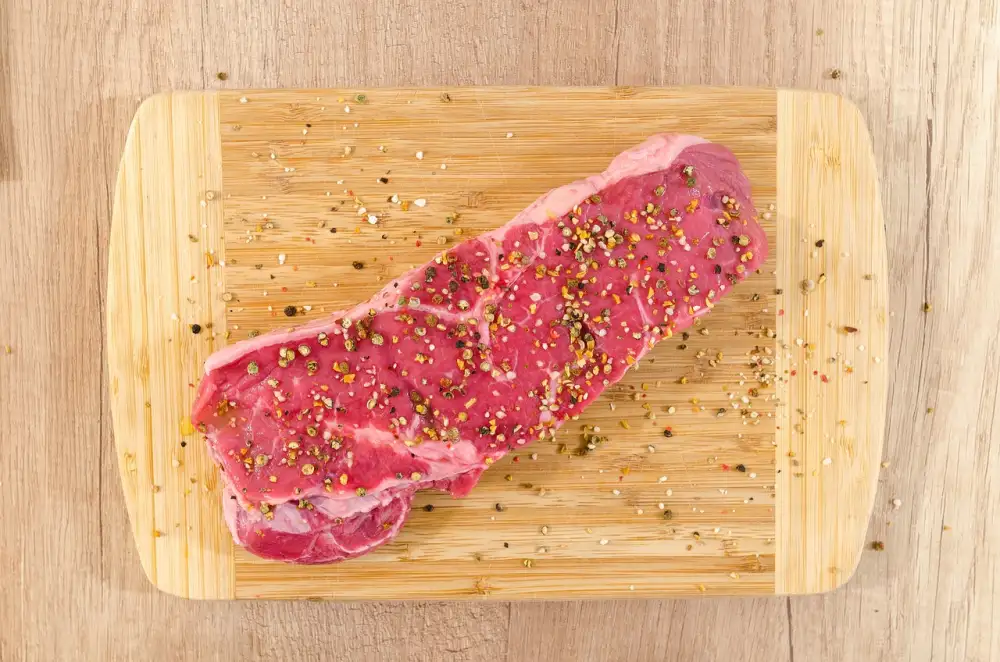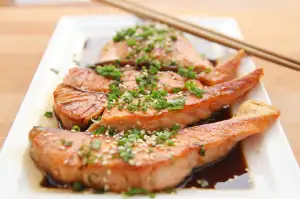Juicy and Flavorful Ribeye Steak Recipe: Indulge in a Culinary Delight!

- Introduction to Ribeye Steak
- Understanding the Ribeye Cut
- Selecting the Perfect Ribeye Steak
- Preparing the Ribeye Steak
- Cooking Techniques for Ribeye Steak
- Enhancing the Flavor of Ribeye Steak
- Serving and Pairing Suggestions for Ribeye Steak
- Tips for Achieving the Perfect Ribeye Steak
- Conclusion: Enjoying the Juicy and Flavorful Ribeye Steak
Introduction to Ribeye Steak
When it comes to indulging in a culinary delight, few dishes can compare to the juicy and flavorful ribeye steak. This succulent cut of beef is known for its marbling, which gives it a rich and tender texture. Whether you're a seasoned steak lover or new to the world of fine dining, the ribeye steak is sure to satisfy your taste buds and leave you craving more. In this article, we will explore everything you need to know about this mouthwatering cut of meat, from understanding the ribeye cut to selecting the perfect steak and mastering cooking techniques that will elevate your dining experience. So get ready to savor the flavors of life as we dive into the world of ribeye steak!
Understanding the Ribeye Cut
Understanding the Ribeye Cut:
The ribeye steak is a popular and highly sought-after cut of beef that is known for its exceptional tenderness and rich flavor. It comes from the rib section of the cow, specifically from the rib primal cut. This area is located between the shoulder and loin, making it a well-marbled and flavorful piece of meat.
The ribeye cut is characterized by its generous marbling, which consists of streaks of fat running throughout the meat. This marbling not only adds flavor but also helps to keep the steak moist and juicy during cooking. The fat content in the ribeye gives it a buttery texture and contributes to its succulence.
There are two main types of ribeye cuts: bone-in and boneless. The bone-in ribeye, also known as a cowboy steak or tomahawk steak, includes a portion of the rib bone, which adds extra flavor and presentation value. On the other hand, boneless ribeyes are more convenient for those who prefer easy carving.
When selecting a ribeye steak, look for one with even marbling throughout the meat. The ideal amount of marbling will vary depending on personal preference, but generally, more marbling means more flavor and tenderness. Additionally, choose steaks with bright red coloration as this indicates freshness.
By understanding the unique characteristics of the ribeye cut, you can better appreciate its superior taste and make informed choices when purchasing this delectable piece of beef.
Selecting the Perfect Ribeye Steak
When it comes to selecting the perfect ribeye steak, there are a few key factors to consider. First and foremost, look for a steak that has marbling throughout the meat. Marbling refers to the streaks of fat running through the muscle, which adds flavor and juiciness to the steak when cooked. The more marbling, the better.
Additionally, choose a ribeye steak that is thick-cut. A thicker steak will allow for more even cooking and will retain its juiciness better than a thinner cut. Look for steaks that are at least 1 inch thick or more.
Another important aspect to consider is the color of the meat. Look for a ribeye steak that has a bright red color with a slight pink hue. Avoid steaks that have a grayish tint or any discoloration.
Lastly, pay attention to the grade of the ribeye steak. The USDA grades beef based on its quality, with Prime being the highest grade followed by Choice and Select. Prime grade ribeye steaks will have superior marbling and tenderness compared to lower grades.
By selecting a ribeye steak with ample marbling, thickness, vibrant color, and high-grade quality, you can ensure that you are choosing the perfect cut for an indulgent culinary experience.
Preparing the Ribeye Steak
Preparing the Ribeye Steak is an essential step to ensure a delicious and tender result. Start by removing the steak from the refrigerator and allowing it to come to room temperature for about 30 minutes. This will help it cook more evenly. Next, pat the steak dry with paper towels to remove any excess moisture. Season generously with salt and pepper on both sides, pressing the seasoning into the meat for optimal flavor penetration. Let the steak sit for another 10-15 minutes to allow the seasoning to penetrate. Finally, brush the steak with a light coating of olive oil to promote browning and prevent sticking during cooking. With these simple steps, you are now ready to move on to the next stage of creating a mouthwatering ribeye steak.
Cooking Techniques for Ribeye Steak
When it comes to cooking a ribeye steak, there are several techniques you can use to achieve the perfect level of doneness and flavor. One popular method is grilling, which imparts a smoky flavor and creates beautiful grill marks on the steak. Another option is pan-searing, which allows for a delicious crust to form on the outside while keeping the inside juicy and tender. For those who prefer a more hands-off approach, oven-roasting is an excellent choice. This method ensures even cooking throughout the steak and allows you to control the internal temperature precisely. Whichever technique you choose, make sure to let the steak rest for a few minutes before slicing into it. This allows the juices to redistribute, resulting in a more tender and flavorful bite. Experiment with different cooking techniques to find your favorite way of preparing this delectable cut of meat.
Enhancing the Flavor of Ribeye Steak
To truly elevate the flavor of your ribeye steak, there are a few techniques you can employ. One popular method is marinating the steak before cooking. This not only adds flavor but also helps to tenderize the meat. A simple marinade of olive oil, garlic, herbs, and a splash of Worcestershire sauce can work wonders.
Another way to enhance the flavor is by using a dry rub. A combination of spices such as paprika, black pepper, salt, and cayenne pepper can create a delicious crust on the steak when seared.
For those who enjoy a smoky flavor, grilling the ribeye steak over charcoal or wood chips can add depth and complexity to the taste. The charred edges and smoky aroma will take your dining experience to another level.
Lastly, consider adding a finishing touch to your cooked ribeye steak. A pat of herb butter or a drizzle of balsamic reduction can provide an extra burst of flavor that will leave your taste buds dancing with delight.
Remember, enhancing the flavor of your ribeye steak is all about experimenting with different ingredients and techniques until you find what works best for you. So go ahead and get creative in the kitchen – your taste buds will thank you!
Serving and Pairing Suggestions for Ribeye Steak
When it comes to serving and pairing suggestions for ribeye steak, the possibilities are endless. One classic option is to serve it with a side of creamy mashed potatoes and roasted vegetables. The richness of the potatoes complements the juicy flavors of the steak perfectly.
For a lighter option, consider serving your ribeye steak alongside a fresh salad. A mix of crisp greens, cherry tomatoes, and tangy vinaigrette will provide a refreshing contrast to the rich meat.
If you're looking to elevate your dining experience, try pairing your ribeye steak with a glass of full-bodied red wine such as Cabernet Sauvignon or Malbec. The robust flavors of these wines will enhance the richness of the steak.
For those who prefer non-alcoholic options, a glass of sparkling water infused with lemon or lime can be a refreshing accompaniment to cut through the richness of the meat.
Remember that presentation is key when serving ribeye steak. Consider slicing it against the grain and arranging it on a platter before serving. This not only makes it easier for guests to enjoy but also adds an elegant touch to your meal.
Whether you choose classic sides or experiment with new flavors, serving and pairing suggestions for ribeye steak are all about enhancing its natural flavors while adding complementary elements. So go ahead and savor every bite of this juicy and flavorful culinary delight!
Tips for Achieving the Perfect Ribeye Steak
Tips for Achieving the Perfect Ribeye Steak:
1. Start with a high-quality cut: Look for marbling throughout the steak, as this will ensure tenderness and flavor.
2. Let it come to room temperature: Take the ribeye out of the fridge at least 30 minutes before cooking to allow it to reach room temperature. This will help it cook evenly.
3. Season generously: Use a combination of salt, pepper, and any other desired seasonings to enhance the flavor of the ribeye. Don't be afraid to be generous with your seasoning.
4. Preheat your grill or pan: Make sure your cooking surface is hot before placing the ribeye on it. This will help create a nice sear on the outside while keeping the inside juicy.
5. Sear first, then finish: Start by searing both sides of the ribeye over high heat to lock in the juices. Then, reduce the heat and continue cooking until desired doneness is reached.
6. Use a meat thermometer: To achieve your preferred level of doneness, use a meat thermometer to check the internal temperature of the steak. For medium-rare, aim for around 135°F (57°C).
7. Let it rest: After cooking, let the ribeye rest for about 5 minutes before slicing into it. This allows the juices to redistribute throughout the meat, resulting in a more flavorful steak.
8. Slice against the grain: When ready to serve, slice against the grain of the meat for maximum tenderness.
By following these tips, you'll be able to savor every bite of your perfectly cooked ribeye steak and enjoy its juicy and flavorful goodness!
Conclusion: Enjoying the Juicy and Flavorful Ribeye Steak
In conclusion, indulging in a juicy and flavorful ribeye steak is truly a culinary delight. The tender and succulent meat, combined with the rich marbling and intense flavor, creates a memorable dining experience. Whether you prefer grilling, pan-searing, or broiling, the key is to cook it to perfection while preserving its natural juices. By following the tips and techniques mentioned earlier, you can achieve a perfectly cooked ribeye steak every time. So go ahead, savor the flavors of life with this delectable cut of beef and treat yourself to a truly satisfying meal!
Published: 15. 11. 2023
Category: Recipes



